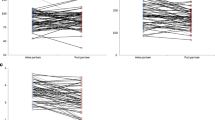Abstract
One major problem for patients with myelomeningocele (MMC) is fecal incontinence. To prevent this problem, fetal surgery for repair of MMC has been recently undertaken. The strategy behind this surgery is to allow normal development of anal sphincter muscles. The purpose of this study was to determine whether fetal surgery for repair of MMC allows normal development of anal sphincter muscles. Myelomeningocele was surgically created in fetal sheep at 75 days of gestation. At 100 days of gestation, fetal surgery for repair of the MMC lesion was performed. Three repair methods were used: standard neurosurgical repair (4 fetal sheep), covering the MMC lesion with Alloderm (2 fetal sheep), and covering the MMC lesion with Gore-Tex (2 fetal sheep). After the sheep were delivered (140 days of gestation), external and internal anal sphincter muscles were analyzed histopathologically. In control fetal sheep (not repaired) anal sphincter muscles did not develop normally. In contrast, in fetal sheep that underwent repair of the MMC, the external and internal anal sphincter muscles developed normally. Histopathologically, in the external sphincter muscles, muscle fibers were dense. In the internal sphincter muscles, endomysial spaces were small, myofibrils were numerous, and fascicular units were larger than those in unrepaired fetal sheep. There was no difference in muscle development for the repair methods. Fetal surgery for repair of MMC allows normal development of anal sphincter muscles.



Similar content being viewed by others
References
Lary JM, Edmonds LD (1996) Prevalence of spina bifida at birth, United States, 1983–1990: a comparison of two surveillance systems. Mor Mortal Wkly Rep CDC Surveill Summ 45:15–26
Olutoye OO, Adzick NS (1999) Fetal surgery for myelomeningocele. Semin Perinatol 23:462–43
Westerburg B, Jennings RW, Harrison MR (1999) New perspectives in fetal surgery: prenatal repair of myelomeningocele. In: Chervenak FA, Kurjak A (eds) Fetal medicine. Parthenon, Pearl River, New York, pp 254–264
Paek BW, Farmer DL, Wilkinson CC, Albanese CT, Peacock W, Harrison MR, Jennings RW (2000) Hindbrain herniation develops in surgically created myelomeningocele but is absent after repair in fetal lambs. Am J Obstet Gynecol 183:1119–1123
Tulipan N, Hernanz-Schulman M, Bruner JP (1998) Reduced hindbrain herniation after intrauterine myelomeningocele repair: a report of four cases. Pediatr Neurosurg 29:274–278
Meuli M, Meuli-Simmen C, Yingling CD, Hutchins GM, Timmel GB, Harrison MR, Adzick NS (1996) In utero repair of experimental myelomeningocele saves neurological function at birth. J Pediatr Surg 31:397–402
Meuli M, Meuli-Simmen C, Hutchins GM, Yingling CD, Hoffman KM, Harrison MR, Adzick NS (1995) In utero surgery rescues neurological function at birth in sheep with spina bifida. Nat Med 1:342–347
Alberto Pena (1994) Congenital etiology. In: Kuijpers HC (ed) Colorectal physiology: fetal incontinence. CRC Press, Boca Raton, Florida, pp 47–54
Meuli-Simmen C, Meuli M, Hutchins GM, Yingling CD, Timmel GB, Harrison MR, Adzick NS (1995) Fetal reconstructive surgery: experimental use of the latissimus dorsi flap to correct myelomeningocele in utero. Plast Reconstr Surg 96:1007–1011
Meuli M, Meuli-Simmen C, Yingling CD, Hutchins GM, Hoffman KM, Harrison MR, Adzick NS (1995) Creation of myelomeningocele in utero: a model of functional damage from spinal cord exposure in fetal sheep. J Pediatr Surg 30:1028–1033
Bruner JP, Tulipan NB, Richards WO, Walsh WF, Boehem FH, Vraback EK (1999) In utero repair of myelomeningocele: a comparison of endoscopy and hysterotomy. Fetal Diagn Ther 15:83–88
Heffez DS, Aryanpur J, Hutchins GM, Freeman JM (1990) The paralysis associated with myelomeningocele: clinical and experimental data implicating a preventable spinal cord injury. Neurosurgery 27:987–992
Heffez DS, Aryanpur J, Rotellini NA, Hutchins GM, Freeman JM (1993) Intrauterine repair of experimental surgically created dysraphism. Neurosurgery 32:1005–1010
Hutchins GM, Meuli M, Meuli-Simmen C, Jordan MA, Heffez DS, Blakemore KJ (1996) Acquired spinal cord injury in human fetuses with myelomeningocele. Pediatr Pathol Lab Med 16:701–712
Meuli M, Meuli-Simmen C, Hutchins GM, Seller MJ, Harrison MR, Adzick NS (1997) The spinal cord lesion in human fetuses with myelomeningocele: implication for fetal surgery. J Pediatr Surg 32:448–452
Shapiro E, Seller MJ, Lepor H, Kaousek DK, Hutchins GM, Perlman EJ, Meuli M (1998) Altered smooth-muscle development and innervation in the lower genitourinary and gastrointestinal tract of the male human fetus with myelomeningocele. J Urol 160:1047–1053
Younoszai MK (1992) Stooling problems in patients with myelomeningocele. South Med J 85:718–724
Marti MC (1990) Anal incontinence. In: Mati MC, Givel JC (eds) Surgery of anorectal diseases. Springer, Berlin Heidelberg New York, pp 205–207
Acknowledgement
We thank M. Zeiger, University of California, San Francisco, for editorial assistance.
Author information
Authors and Affiliations
Corresponding author
Rights and permissions
About this article
Cite this article
Yoshizawa, J., Sbragia, L., Paek, B.W. et al. Fetal surgery for repair of myelomeningocele allows normal development of anal sphincter muscles in sheep. Ped Surgery Int 20, 14–18 (2004). https://doi.org/10.1007/s00383-003-1073-7
Published:
Issue Date:
DOI: https://doi.org/10.1007/s00383-003-1073-7




